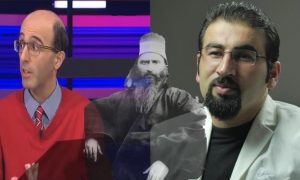According to Baha’ism logic, as long as violence occurs against the Baha’ism organization or the universal dominance system is bad and people like Erfan Sabeti introduces it as an indecent and radical culture of Iranian people. However, it will be introduced as the legitimate right by Baha’ism mercenaries like Morteza Ismaeel pour if it is used to repress Baha’ism protesters or truth seeking Baha’is.
Calling on violence in oppositions by Morteza Ismaeel pour became an excuse for the origin of violence, the slander of violence and the criterion for accepting violence are investigated. After increasing some item prices and change in the kind of paying subsides to people, Morteza Ismaeel pour, the media mercenary of Baha’ism called on the protesters of the new plan to nationwide violent oppositions.
Assuming using violence against security forces of the country as the legitimate right for protesters, the Baha’i media mercenary said: “The legitimate defense is people’s right, but extensive oppositions can afflict the regime and if necessary it can be answered by violence. The lack of each kind of violence is merely important when oppositions are started. When we are in majority, we can gain power.[1]”
However, inviting to violence in oppositions by Baha’ism media hired worker became an excuse for violence seeking, accusing the tendency towards violence and the criterion for accepting violence to be investigated.
- The historical principle of violence in Baha’ism: Using violence against opponents can be considered as a historical principle; as the self-proclaimed prophet of Baha’ism himself was one of the heads of Babism terroristic movement in Iran. He was even omitting his opponents physically in Iraq after he was exiled.[2] His followers didn’t shrink using violence and removing the opponents physically. The following cases can be used as examples: The role of Baha’is in assassinating Sheikh Fadhlullah Nouri, Seyyed Abdullah Behbahani, the abortive assassination of Naseruddin Shah, killing Babi proselytizers, their role in killing Sheikh Zakaryya Nasirul Islam, murdering Seyyed Abul Hassan Kalantar Sirjan, the ruthless massacre of Abarqou and etc.[3]
- The theological principle of violence in Baha’ism: Inviting to violence and brutality is considered as a theological principle in this cult. Inviting to violence against the opponents by the self-proclaimed prophet of Baha’ism[4] or the commandment of ruthless excommunication and general sanction against the opponents and ex-Baha’is are of the cases.[5]
- Accusing or inviting to violence for or against others: Although violence is a historical and intellectual principle in Baha’ism cult, but this cult has attributed violence to the Iranian culture and decry it. As Erfan Sabeti, one of the activists in Baha’ism media introduces violence as a principle in the Iranian culture[6] and in another place he orders it for assassinating his opponents!
- The criterion for goodness or badness of violence in Baha’ism: If violence hurts the Baha’i organization or the interests of the universal dominance system, it will be bad and people like Erfan Sabeti will consider it as bad, but if violence and avoiding rationality and affection is used for repressing Baha’ism opponents or confronting against truth-seeking Baha’is, it will be introduced as necessary and the legitimate right by hired workers of Baha’ism like Morteza Ismaeel pour.
[۱] Narrated by hired media related to the Baha’ism organization.
[۲] Refer to Ezziyeh Nouri, Tanbihunnaemin (the warning to the sleep), the faithful of the Bayan, the electronic copy, pp. 11-12.
[۳] For more studies refer to the article: what did the killer Baha’is do in Iran? + images.
[۴] Hussein Ali Nouri, the works of the Highest Pen, the electronic copy, Vol. 2, p. 89.
[۵] Helen Hornby, the guidance lights, the electronic copy, p. 230, No. 604.
[۶] For more studies refer to the article: Manoto network’s insulting to Iranian people and culture.






